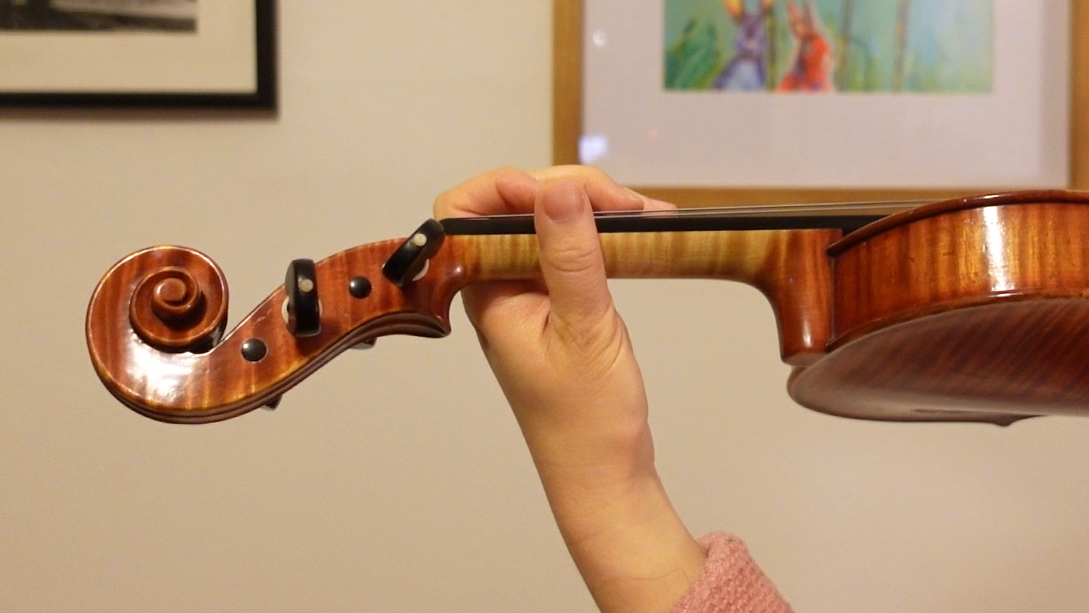An interview with Sotai Practitioner Kenichi Kiyama
For violinists who have struggled with playing-related pain despite trying countless remedies, a Japanese assisted-exercise method called Sotai may offer relief. Sotai practitioner Kenichi Kiyama, a professional violinist, martial artist, and the owner of Kiyama Bodyworks, LLC, explains how Sotai helps violinists reset their nervous system. He also highlights the importance of dynamic movement, why stretching is not always the answer, and shares a simple at-home recovery exercise for violinists.
During a visit to Kenichi’s office, I experienced a Sotai appointment firsthand. After an assessment of my discomfort issues, he guided me through some assisted resistance exercises. He also had me bring my violin to the appointment. We tried some different posture exercises which not only made holding the violin feel more comfortable but also helped me produce a richer tone quality. By the end of the session, my body felt more balanced, and I moved with more ease. From my perspective, Sotai is a unique and effective approach to help violinists overcome pain-inducing movement patterns.
The following article offers helpful information for violinists and anyone else who has struggled with physical discomfort or pain. If you’d like to book a Sotai appointment with Kenichi in Evanston, IL, you can find him at his website. He is also available for remote appointments.
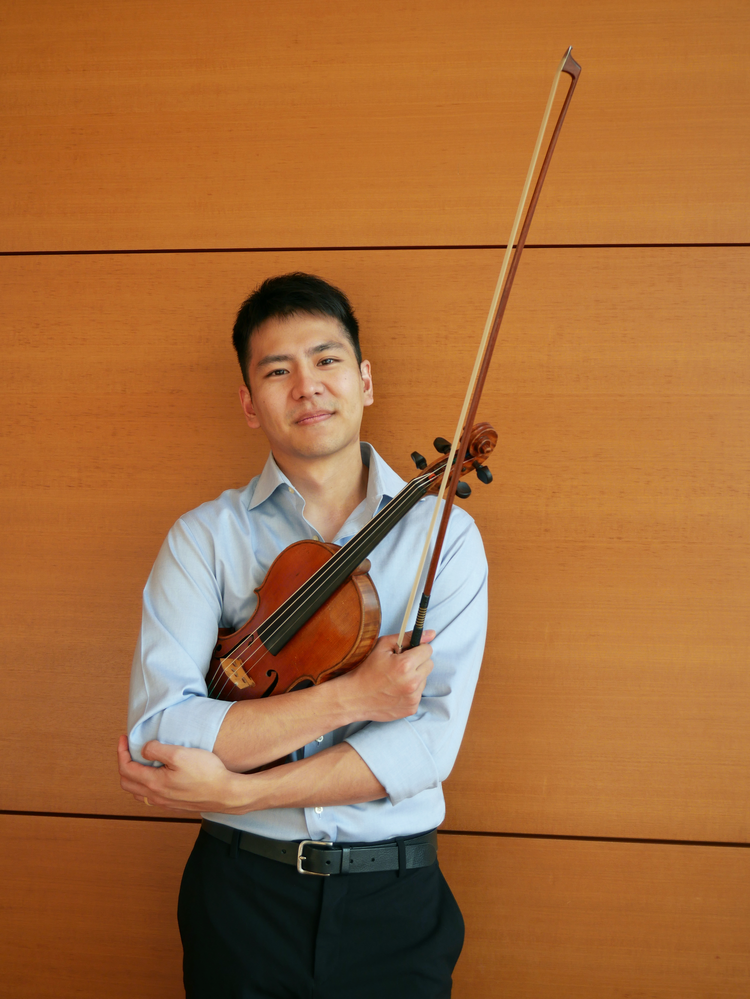
Kiyoe: How would you describe yourself?
Kenichi: I’ve often been described as a Renaissance man, because I work and have interests in different areas. I did a lot of sports including martial arts for a long time. I still try to work out regularly. And then I became a violinist, and now I do Sotai. They’re all equally important to me.
Kiyoe: Did you ever experience violin playing-related pain?
Kenichi: I didn’t have any violin related injuries until I got to college (although I have many minor injuries from sports). The violin injury that I had are in both of my index fingers, which don’t have very good muscle recruitment. I suppose you could say the injury closely resembles trigger finger or overuse injury. But I think I did succumb to this injury because this was the time where I wasn’t exercising as much as I did or am now and also because of bad technique and lots of experimental technique, because I was trying to see if I can accelerate my progress in violin playing.
Kiyoe: What were your first attempts to solve your own violin playing-related pain or discomfort?
Kenichi: Oh, I did what everybody else did. I tried every shoulder rest and every chinrest combination you could possibly think of. I struggled with set-up issues for my entire undergrad because it just felt uncomfortable. Currently, I am alternating between nothing at all to a small red sponge. The reason is that I can feel the instrument better like the string angle, vibrations, how my hands move, etc. I’m still not a hundred percent satisfied. I think it’s also partially because I am still growing.
Kiyoe: Regarding violin set-up, it’s so common for people to try changing their sponges and shoulder rests and chin rests in order to get comfortable. How much do you think that set-up really matters, or is it more about good alignment in your own body? Or are they equally important?
Kenichi: That is a very multi-layered question. My philosophy, which I think is controversial from the common practice, is that most people get a little bit too carried away with the fact that everybody’s body is a little bit different. That in itself can drive people too far from figuring out a sustainable solution. We are all technically built the same way, with slight variation.
I think it’s more productive to find the right angles of placement for the instrument and bow that work with your natural body posture so that both hands can move freely.
In short, I would say figure out your body alignment first and then find your shoulder rest and chin rest set-up later, because you don’t want to adapt yourself to the instrument. You want the instrument to adapt to you. And be patient because on top of all that the body is striving for equilibrium which then changes positioning depending on stress, mood, rest… Its a fickle thing.
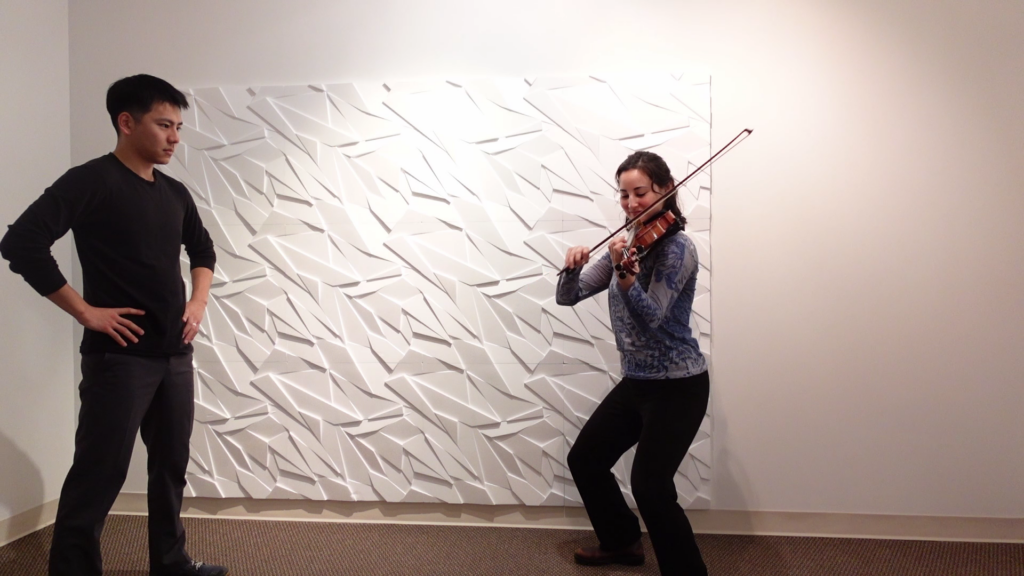
Kiyoe: How did you get introduced to Sotai?
Kenichi: My father. He’s an extraordinarily gifted acupuncturist, and martial artist. He came across Sotai by accident about 8 years ago and found it to be very successful, in some cases more than acupuncture. It was already my intention to, at some point in my violin career, migrate towards this field of helping people out of pain, because I know that the music world has a tendency to be a little bit far behind in understanding how the body works, and understanding how to take care of yourself physically. So my father taught me the basics and then I brought what I had learned about Sotai, to Chicago, and I experimented on all my friends. Eventually, people around me were getting more curious and encouraged me to make it into a business. So far the consensus was that Sotai is very different, and also it works really well. And so now I have my own practice.
Kiyoe: How would you describe what Sotai is to people who have never heard of it?
Kenichi: Generally speaking, on paper, Sotai is an assisted exercise to help restore ease of movement. The idea is that everybody gets caught up into a similar movement pattern, and the one time that they don’t move the way that they’re used to is when they get hurt. Sotai helps unwind all of that. Even though that is what it says in literature, most of my clients don’t quite know how to describe the experience either other than it works.
Here is the explanation I give to people to give them a better picture: Say, I tried to push down a solid concrete wall. It’s impossible to move. But as you’re pushing, you’ll feel in your own body that some areas that are not perfectly reinforced and so you’ll instinctively make those small changes, and then you’ll feel stronger even though you’re not going to move the wall. Sotai is like that but on a much smaller scale and I can tailor the angles and the direction of movement appropriately to the needs of the client. Its low impact, painless, and it should leave you feeling lighter and flowy.
To add onto this, something that I am learning as I am seeing more people, is that we are actually correcting the person’s muscle relationship with the nervous system as it becomes overactive trying to compensate for imbalances. If you can fix that, you can solve a lot of problems.
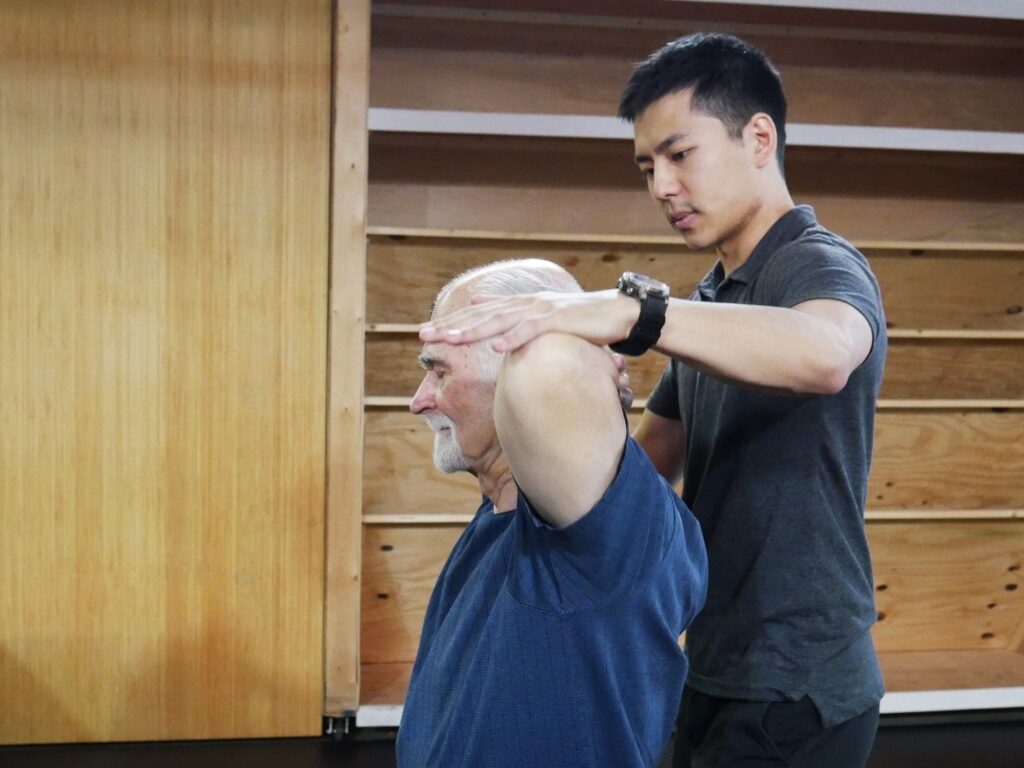
Kiyoe: How would you say Sotai can specifically help violinists?
Kenichi: So, a lot of people reading this will have or be anticipating one of a few things: shoulder pain/tension, lower back pain/tension, finger pain/tension, or arm and forearm pain/tension.
Let’s say the top of your shoulder is hurting or super tense.
It could be that
- your shoulder blades are too high, or too far away from your spine
- that your posture is bad that your other muscles are trying to keep your body up that it’s compensating.
- Bones structure is not the optimal place
- Overactive muscles…
There are too many factors to consider when addressing these issues.
When playing violin, we already know its not a natural position to be in. However, (hopefully I won’t make people made when I say this) is that most violinists don’t do a lot of exercise. So their muscle structure tailor to the instrument. We get stuck doing the same movement pattern over and over again. Plus, we are sitting or standing but in the same awkward position which eventually leads to some form of compensation in the overall posture.
Sotai can help recondition the nervous system and restore the proper ease of movement and better reinforce the muscular structure which in turn also helps address posture. A lot of times, I find that people have no idea how they are supposed to feel. They get used to how their bodies feel and lose sight of what ease of movement is supposed to feel like.
BUT Sotai doesn’t work by itself. Ideally it has be paired with some sort of resistance exercise because the resistance exercise will help keep your muscles strong so that it maintains its structure better. If stimulated correctly, they can adapt and anticipate with ease with less negative consequences. I try to assign some homework for my clients to do on their own.
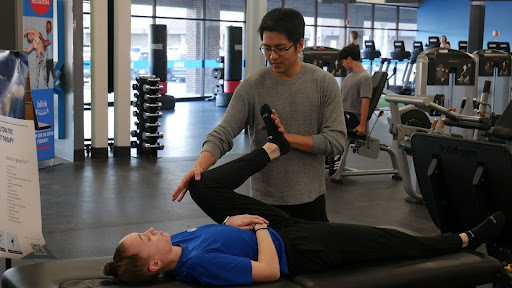
Kiyoe: That leads me nicely to my next question: what are some exercises that you recommend that violinists can do at home?
Kenichi: Oh, there are so many! Now everyone has unique issues they are dealing with so I can’t recommend a specific exercise. But to give a simple and general solution, I say a consistent whole body exercise regime will take care of a lot.
Now of course since we deal with our hands specifically, one thing that I’m testing out now is the very economic old-school martial arts training tool, which is rice in a bucket. It sounds silly, but one problem is that when we have to deal with our hands a lot, there’s a lot of tools to train gripping power but very limited extensor tools. I find that most of the devices that are available on the market are awkward and don’t train the hands “holistically” enough. So I decided to put rice in a bucket and then move around in there and see if that does anything.
Kiyoe: Uncooked rice?
Kenichi: Yeah, don’t use cooked rice because you’ll burn your hand! So just throw it in there. One hand at a time, or if you get enough rice and a large enough bucket, you can do both hands at the same time. Quite frankly, I find that a much more effective aftercare tool than stretching.
Kiyoe: What violin injuries would the rice-in-a-bucket exercise help prevent?
Kenichi: I would say anything lower arm to hand specific, the rice will help prevent almost all of them. My general solution for everything is to move as dynamically as you possibly can and do resistance exercies. You don’t want your muscles to get surprised by anything.
So some exercises with the rice bucket would be simply trying to open or close your hand submerged in the rice. You can make it a game but also twisting your arm as you grip or extend your fingers to add some “functionality” to it. Honestly, just play with the rice like a child would and be generous with your movement (with great care and caution) move through the rice while stretching through your fullest range. It feels good and as a bonus, you can make your hands smoother.
I generally try to stay away from stretching as a primary solution because of what I explained before. You have no idea what might be causing your issues.
Tension/feeling tense, or limited range of motion, is caused by your muscles trying to protect itself from injury. The nervous system is extraordinary and intuitive. If the body feels like its under attack, like the immune system, it has protocols to protect the body. Muscles have a tendency to become shortened or strong when they feel threatened.
So things like shoulder pain or back pain have almost little to do with the actual area of pain. It mostly has to do with a much smaller and deeper muscle trying to protect something, and all the surrounding bigger muscles are working overtime to compensate for that imbalance of function. Or along the chain of muscles that create a particular movement, one particular muscle is not being stimulated to work properly, which makes the others/surrounding muscles work harder pushing things out of alignment.
Muscles, from what I have read, are capable of stretching to 130% of its capacity. Which is why stretching doesn’t necessarily solve the issues people may be having. If you are going to stretch, you have to make sure that all of your muscles are functioning properly to stretch, because all you might be doing is just pulling on a tendon. If your muscles are not relaxed, it’s basically like a rubber band got tied in a knot, and you’re trying to pull it apart. You could try to help that process with massage as home-care. But you have to be very specific about how you do [massage], because if you do it like everybody else does, it’s like beating up a muscle and there are so many layers of muscle, it’s impossible to actually get to the issue unless you know where to start.
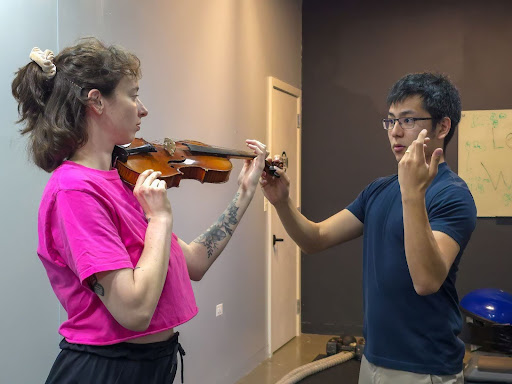
Kiyoe: For people that might not know, what do you mean by moving dynamically?
Kenichi: I would say that my definition of moving dynamically is controlled movement in the most extreme ranges without overdoing it. Like doing a super deep squat. [Moving dynamically and resistance exercise will help] to anticipate random, sudden movements [that cause may cause injury]. Like in any sport, you can’t eliminate injury. The better you get, your level of risk also goes up BUT you can minimize negative consequences with the right tools.
If you don’t move it, you really do lose it and as you age, it gets harder to get it back. So to keep it simple, as long as you can move with as much range as possible, and do resistance training to secure the muscles, it’s going to mitigate the risk [of injury] a lot more than doing nothing. A bonus of doing resistance exercises, the strengthening will also help improve musicians playing endurance. Win-win.
Kiyoe: Are most of your clients musicians?
Kenichi: 30% to 40% of them are musicians, I have about the same percentage of athletes/martial artists as well. The rest are recommendations from others or people that I met randomly.
Kiyoe: Do your clients usually feel like Sotai is the answer for their violin-related pain problems?
Kenichi: So far, it appears to be a good solution for most. I am a rather transparent person (in a good or bad way). I think most other modalities like massage therapy, acupuncture, or chiropractic would agree with me that everything has its limits. I don’t like claiming that Sotai is the solution for everyone and it can fix all your problems. I have had clients try everything from physical therapy to chiro to Reiki, and then they found me and it worked. Which of course validates that I am doing something worthwhile.
I can promise that I will do my best to help all my clients to the fullest.
I have found that the results of what I do either fix the problem (ideally), speed up the recovery process, or find a problem that no one noticed before, or help manage pain.
The “finding a problem that no one has noticed” scenario has happened more often that I anticipated.
For example, I had one client who’s a violinist, and she came to me because she had hip issues. She got removed by forceps when she was a baby, and so her hips got dislocated and stayed that way for 60 years. She had surgery for it a while back and it was going well till the other hip started to bother her. She had a suspicion that she was going to need another hip surgery even though the doctor said she was fine. I met her at this time and was able to help manage her pain but I started to notice that there were some weird inconsistencies. I was convinced that one leg was still a couple millimeters off along. Even though I could manage pain significantly, something was not taking. So she went to a specialist and it turns out a lot of my suspicions and hers were correct. So I think she’s doing much better now.
Kiyoe: How can people contact you if they want more resources or if they want to work with you?
Kenichi: If you’re a musician who’s in the Chicago area, my services are not terribly expensive, and I will try to address as much as I can with you. And then of course I offer a sliding scale for anybody who comes in because my job in this business is not to take your money, it’s to help you as best as I can. I’m pretty honest; if I feel like I can’t do anything to help you I will tell you right away.
If you would like to work with Kenichi, you can connect with him through his website, https://kiyamastudios.com/kiyama-bodyworks-llc
If you had any takeaways from this interview, please leave them in the comments below!
I have more articles about violin-related pain based on my own experience as a violinist and yoga instructor:
- How To Deal With Recurring Violin Pain
- How to Solve Shoulder Pain for Violinists
- How To Overcome Left-hand Pain While Playing Violin
- 5 New Strategies For Violin Neck and Shoulder Pain
- How to Hold the Violin to Relieve Neck Pain
And if you enjoy reading musician interviews, you should check out my interview with keyboardist Sun Chang, and my interview with non-profit music ensemble co-founder Seth Van Embden.
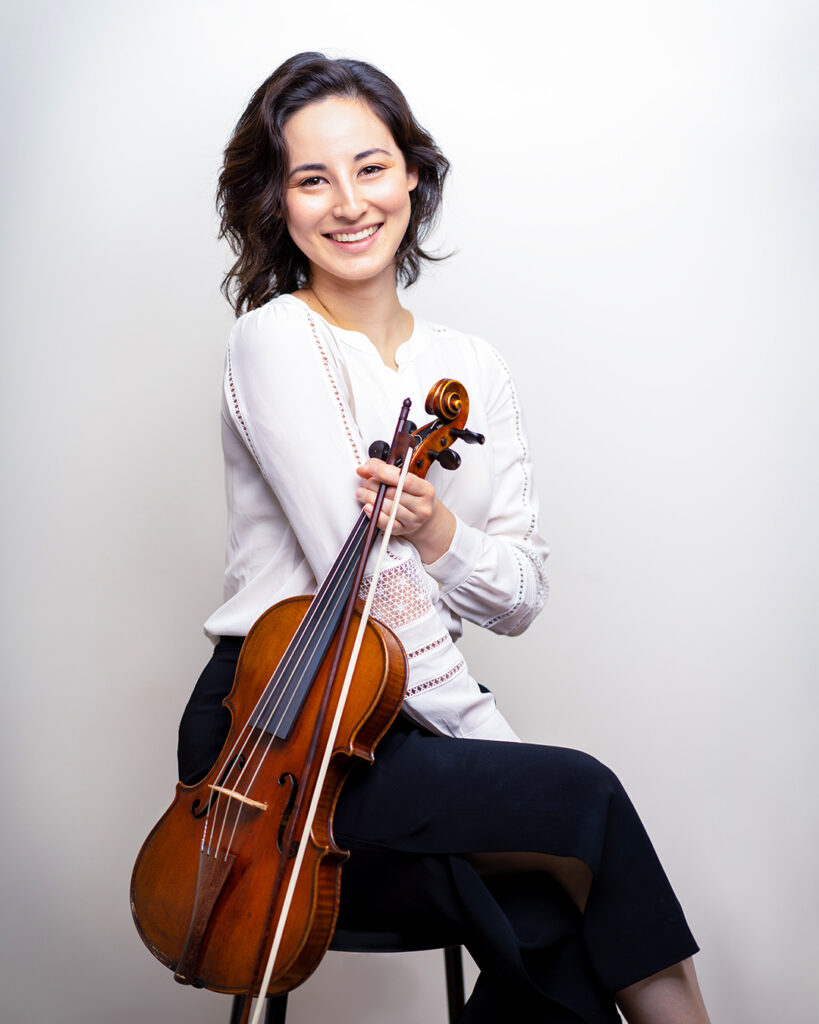
Kiyoe Matsuura is a freelance violinist specializing in baroque performance. She is also co-founder of the duo Ensemble Vitelotte, and runs a YouTube channel focusing on violin student repertoire. She has written numerous articles on violin pain prevention, practicing, and pedagogy.
Latest Posts
How To Do a 180° Career Change As A Classical Musician
As a musician, I’ve had moments of wondering what life would be like to go through a career change. …
What It’s Like To Fulfill Your Parents’ Musical Dreams
With discipline, talent, and passion for orchestral music, 32-year-old cellist Sonia Mantell has alr…
How To Treat Violin-Related Pain and Injuries With Sotai
For violinists who have struggled with playing-related pain despite trying countless remedies, a Jap…
How To Build A Nationally-Recognized Non-Profit Music Ensemble
Starting a non-profit music ensemble is a dream shared by many musicians, but turning that dream int…
How Friendships and Passion Shape A Meaningful Life In Music
Have you ever reflected on the values that guide your career as a musician? Pianist, harpsichordist,…
How To Overcome Left-hand Pain While Playing Violin
Left-hand and arm pain while playing violin is a common challenge for students. As a violin teacher,…




